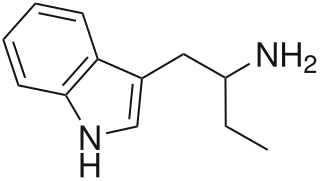
α-Ethyltryptamine, also known as etryptamine, is a psychedelic, stimulant, and entactogenic drug of the tryptamine class. It was originally developed and marketed as an antidepressant under the brand name Monase by Upjohn in the 1960s.

4-Hydroxy-N,N-diisopropyltryptamine is a synthetic psychedelic drug. It is a higher homologue of psilocin, 4-HO-DET, and is a positional isomer of 4-HO-DPT and has a tryptamine molecular sub-structure.

Diisopropyltryptamine is a psychedelic hallucinogenic drug of the tryptamine family that has a unique effect. While the majority of hallucinogens affect the visual sense, DiPT is primarily aural.

DET, also known under its chemical name N,N-diethyltryptamine and as T-9, is a psychedelic drug closely related to DMT and 4-HO-DET. However, despite its structural similarity to DMT, its activity is induced by an oral dose of around 50–100 mg, without the aid of MAO inhibitors, and the effects last for about 2–4 hours.

4-HO-MiPT is a synthetic substituted aromatic compound and a lesser-known psychedelic tryptamine. It is thought to be a serotonergic psychedelic, similar to magic mushrooms, LSD and mescaline. Its molecular structure and pharmacological effects somewhat resemble those of the tryptamine psilocin, which is the primary psychoactive chemical in magic mushrooms.

5-MeO-DPT, is a psychedelic and entheogenic designer drug.
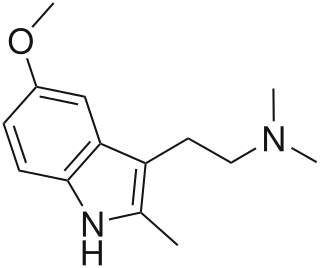
5-Methoxy-2,N,N-trimethyltryptamine is a psychoactive drug of the tryptamine chemical class which acts as a psychedelic. It was first synthesized by Alexander Shulgin and reported in his book TiHKAL. 5-MeO-TMT is claimed to show psychoactive effects at a dosage of 75–150 mg orally, but these are relatively mild compared to those of other similar compounds. This suggests that while the methyl group on the 2-position of the molecule has impaired the binding of metabolic enzymes like monoamine oxidase (MAO), it is also interfering with binding to and/or activation of the serotonin 5-HT2A receptor, the target responsible for mediating the hallucinogenic effects of such compounds.

2C-T-17 or 2,5-dimethoxy-4-(β-secbutylthio)phenethylamine is a psychedelic phenethylamine of the 2C family. It was presumably first synthesized by Alexander Shulgin and reported in his book PiHKAL .

N,N-Dibutyltryptamine (DBT) is a psychedelic drug belonging to the tryptamine family. It is found either as its crystalline hydrochloride salt or as an oily or crystalline base. DBT was first synthesized by the chemist Alexander Shulgin and reported in his book TiHKAL . Shulgin did not test DBT himself, but reports a human dosage of "1 mg/kg i.m." being active, but less so than DMT or DET. This suggests that an active dosage of DBT will be in the 100 mg range. This compound has been sold as a "research chemical" and has been confirmed to be an active hallucinogen although somewhat weaker than other similar tryptamine derivatives. It produces a head-twitch response in mice.
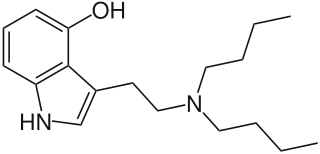
4-Hydroxy-N,N-dibutyltryptamine (4-HO-DBT) is a psychedelic drug belonging to the tryptamine family. It is found either as its crystalline hydrochloride salt or as an oily or crystalline base. 4-HO-DBT was first made by the chemist Alexander Shulgin and reported in his book TiHKAL. Shulgin reported a dosage of 20 mg orally to be without effects. However this compound has subsequently been sold as a "research chemical" and anecdotal reports suggest that at higher doses 4-HO-DBT is indeed an active hallucinogen, although somewhat weaker than other similar tryptamine derivatives.

2-Me-DET, or 2-methyl-diethyltryptamine, is a lesser-known psychedelic drug. It is the 2-methyl analog of DET. 2-Me-DET was first synthesized by Alexander Shulgin. In his book TiHKAL, the minimum dosage is listed as 80-120 mg, and the duration listed as 6–8 hours. 2-Me-DET produces pitch distortion, like that of DiPT. Very little data exists about the pharmacological properties, metabolism, and toxicity of 2-Me-DET.

4-Hydroxy-N-methyl-N-propyltryptamine, commonly known as 4-HO-MPT or meprocin, is a psychedelic drug in the tryptamine class of chemical compounds and is a higher homologue of the naturally occurring substituted tryptamine psilocin as well as being the 4-hydroxyl analog of MPT.

4-MeO-MiPT, or 4-methoxy-N-methyl-N-isopropyltryptamine, is a lesser-known psychedelic drug. It is the 4-methoxy analog of MiPT. 4-MeO-MiPT was first synthesized by Alexander Shulgin and is mentioned in his book TiHKAL. Subsequent testing by Shulgin on human test subjects showed the effective dose as 20-30 mg ; the onset time between ingestion and the first noticeable effects was 45-60 min, with sensations lasting between 2-2.5 hours. The sensation were significantly milder than those of 4-HO-MiPT, with 4-MeO-MiPT producing erotic-enhancing effects, and few of the visuals common with tryptamines. Very little data exists about the pharmacological properties, metabolism, and toxicity of 4-MeO-MiPT.

5-MeO-NMT (5-methoxy-N-methyltryptamine) is an organic chemical compound, being the 5-methoxy analog of N-methyltryptamine (NMT). It was first isolated from Phalaris arundinacea. It has also been synthesized by Alexander Shulgin and reported in his book TiHKAL. Like other members of the N-methyltryptamine family of compounds, 5-MeO-NMT is believed to produce few or no psychedelic effects, although very little data exists about its pharmacological properties or toxicity.
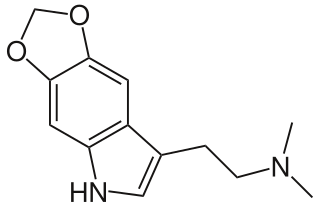
5,6-MDO-DMT, or 5,6-methylenedioxy-N,N-dimethyltryptamine, is a lesser-known psychedelic drug. It is the 5,6-methylenedioxy analog of DMT. 5,6-MDO-DMT was first synthesized by Alexander Shulgin. In his book TiHKAL, 5,6-MDO-DMT produces no noticeable psychoactive effects, although it was only tested up to a dose of 5 mg. Very little data exists about the pharmacological properties, metabolism, and toxicity of 5,6-MDO-DMT.
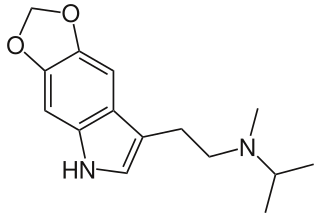
5,6-MDO-MiPT, or 5,6-methylenedioxy-N-methyl-N-isopropyltryptamine, is a lesser-known psychedelic drug. It is the 5,6-methylenedioxy analog of MiPT. 5,6-MDO-MiPT was first synthesized by Alexander Shulgin. In his book TiHKAL, 5,6-MDO-MiPT produces slight paresthesia at low doses. Very little data exists about the pharmacological properties, metabolism, and toxicity of 5,6-MDO-MiPT.

5,6-MeO-MiPT, or 5,6-dimethoxy-N-methyl-N-isopropyltryptamine, is a lesser-known psychedelic drug. It is the 5,6-dimethoxy analog of MiPT. 5,6-MeO-MiPT was first synthesized by Alexander Shulgin. In his book TiHKAL, 5,6-MeO-MiPT produces no noticeable psychoactive effects. Very little data exists about the pharmacological properties, metabolism, and toxicity of 5,6-MeO-MiPT.
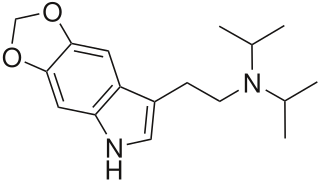
5,6-MDO-DiPT, or 5,6-methylenedioxy-N,N-diisopropyltryptamine, is a lesser-known psychedelic drug. It is the 5,6-methylenedioxy analog of DiPT. 5,6-MDO-DiPT was first synthesized by Alexander Shulgin. It is mentioned in his book TiHKAL, but 5,6-MDO-DiPT was never tested to determine what effects it produces, if any. Very little data exists about the pharmacological properties, metabolism, and toxicity of 5,6-MDO-DiPT.

4,5-MDO-DiPT, or 4,5-methylenedioxy-N,N-diisopropyltryptamine, is a lesser-known psychedelic drug. It is the 4,5-methylenedioxy analog of DiPT. 4,5-MDO-DiPT was first synthesized by Alexander Shulgin. In his book TiHKAL, 4,5-MDO-DiPT produces slight LSD-like effects after several hours. Very little data exists about the pharmacological properties, metabolism, and toxicity of 4,5-MDO-DiPT.
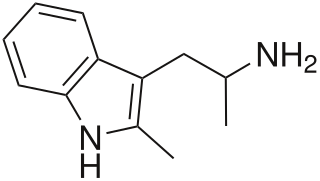
2,α-Dimethyltryptamine (2,α-DMT) is a tryptamine and a lesser-known psychedelic drug. It is the 2,α-dimethyl analog of DMT. Its synthesis was first reported in 1965. Alexander Shulgin lists the dosage as 300-500 mg, and the duration as 7–10 hours in his book TiHKAL. 2,α-DMT causes mydriasis and paresthesia. It also produces a calm, drunk-like feeling. Very little data exists about the pharmacological properties, metabolism, and toxicity of 2,α-DMT.




















